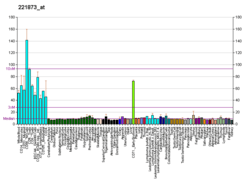ZNF143
Zinc finger protein 143 is a protein that in humans is encoded by the ZNF143 gene.[5]
References
Further reading
- Tommerup N, Vissing H (1995). "Isolation and fine mapping of 16 novel human zinc finger-encoding cDNAs identify putative candidate genes for developmental and malignant disorders". Genomics. 27 (2): 259–64. doi:10.1006/geno.1995.1040. PMID 7557990.
- Schuster C, Myslinski E, Krol A, Carbon P (1995). "Staf, a novel zinc finger protein that activates the RNA polymerase III promoter of the selenocysteine tRNA gene". EMBO J. 14 (15): 3777–87. PMC 394452. PMID 7641696.
- Schaub M, Myslinski E, Schuster C, et al. (1997). "Staf, a promiscuous activator for enhanced transcription by RNA polymerases II and III". EMBO J. 16 (1): 173–81. doi:10.1093/emboj/16.1.173. PMC 1169624. PMID 9009278.
- Schuster C, Krol A, Carbon P (1998). "Two distinct domains in Staf to selectively activate small nuclear RNA-type and mRNA promoters". Mol. Cell. Biol. 18 (5): 2650–8. PMC 110644. PMID 9566884.
- Myslinski E, Krol A, Carbon P (1998). "ZNF76 and ZNF143 are two human homologs of the transcriptional activator Staf". J. Biol. Chem. 273 (34): 21998–2006. doi:10.1074/jbc.273.34.21998. PMID 9705341.
- Rincon JC, Engler SK, Hargrove BW, Kunkel GR (1998). "Molecular cloning of a cDNA encoding human SPH-binding factor, a conserved protein that binds to the enhancer-like region of the U6 small nuclear RNA gene promoter". Nucleic Acids Res. 26 (21): 4846–52. doi:10.1093/nar/26.21.4846. PMC 147939. PMID 9776743.
- Mach CM, Hargrove BW, Kunkel GR (2002). "The Small RNA gene activator protein, SphI postoctamer homology-binding factor/selenocysteine tRNA gene transcription activating factor, stimulates transcription of the human interferon regulatory factor-3 gene". J. Biol. Chem. 277 (7): 4853–8. doi:10.1074/jbc.M108308200. PMID 11724783.
- Strausberg RL, Feingold EA, Grouse LH, et al. (2003). "Generation and initial analysis of more than 15,000 full-length human and mouse cDNA sequences". Proc. Natl. Acad. Sci. U.S.A. 99 (26): 16899–903. doi:10.1073/pnas.242603899. PMC 139241. PMID 12477932.
- Grossman CE, Qian Y, Banki K, Perl A (2004). "ZNF143 mediates basal and tissue-specific expression of human transaldolase". J. Biol. Chem. 279 (13): 12190–205. doi:10.1074/jbc.M307039200. PMID 14702349.
- Gerhard DS, Wagner L, Feingold EA, et al. (2004). "The status, quality, and expansion of the NIH full-length cDNA project: the Mammalian Gene Collection (MGC)". Genome Res. 14 (10B): 2121–7. doi:10.1101/gr.2596504. PMC 528928. PMID 15489334.
- Wakasugi T, Izumi H, Uchiumi T, et al. (2007). "ZNF143 interacts with p73 and is involved in cisplatin resistance through the transcriptional regulation of DNA repair genes". Oncogene. 26 (36): 5194–203. doi:10.1038/sj.onc.1210326. PMID 17297437.
- Myslinski E, Gérard MA, Krol A, Carbon P (2007). "Transcription of the human cell cycle regulated BUB1B gene requires hStaf/ZNF143". Nucleic Acids Res. 35 (10): 3453–64. doi:10.1093/nar/gkm239. PMC 1904299. PMID 17478512.
- Gérard MA, Krol A, Carbon P (2007). "Transcription factor hStaf/ZNF143 is required for expression of the human TFAM gene". Gene. 401 (1–2): 145–53. doi:10.1016/j.gene.2007.07.011. PMID 17707600.
- Yuan CC, Zhao X, Florens L, et al. (2007). "CHD8 associates with human Staf and contributes to efficient U6 RNA polymerase III transcription". Mol. Cell. Biol. 27 (24): 8729–38. doi:10.1128/MCB.00846-07. PMC 2169411. PMID 17938208.
External links
- ZNF143+protein,+human at the US National Library of Medicine Medical Subject Headings (MeSH)
- FactorBook Znf143
This article incorporates text from the United States National Library of Medicine, which is in the public domain.
This article is issued from
Wikipedia.
The text is licensed under Creative Commons - Attribution - Sharealike.
Additional terms may apply for the media files.




